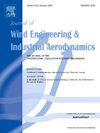桥面光栅对流线型双侧箱梁大跨度悬索人行天桥气动稳定性影响的实验研究
IF 4.9
2区 工程技术
Q1 ENGINEERING, CIVIL
Journal of Wind Engineering and Industrial Aerodynamics
Pub Date : 2024-10-01
DOI:10.1016/j.jweia.2024.105904
引用次数: 0
摘要
在峡谷地区复杂的风环境中,不同类型的桥面光栅(BDGs)常被用作新型气动对策,以改善大跨度悬索人行天桥的抗风性能。然而,如何设计合理的桥面格栅以有效提高大跨度悬索桥的气动稳定性仍是一个亟待解决的问题,目前尚无相关文献报道。因此,本研究根据流线型双侧箱梁(SDSBG)和BDGs的大跨度悬索人行天桥,制作了不同开孔率(β)和BDGs布置的截面模型,然后进行了测力和测振试验,研究了BDGs的布置和β对气动稳定性和飘移稳定性的影响。此外,还研究了 BDG 对扑翼稳定性的影响机理,并提出了最佳的 BDG β 和布局。结果表明:当 0% ≤ β ≤ 22% 时(尤其是 β = 11%),BDGs 对气动稳定性不利;当 β ≥ 44% 时,使用 BDGs 可显著提高气动稳定性;此外,O(β 达到最大值)和 S(沿纵向安装两条 BDGs)两种布局对气动稳定性更有利。因此,有利于气动稳定性的最佳β和北斗七星布局分别为β≥44%和情况O和S的布局,本文的研究可为今后大跨度悬索人行天桥的抗风设计提供有意义的参考。本文章由计算机程序翻译,如有差异,请以英文原文为准。
Experimental investigations on the influence of bridge deck gratings on the aerodynamic stability of the long-span suspension footbridge with a streamlined double-side box girder
In the complex wind environment of canyon regions, different kinds of bridge deck gratings (BDGs) are often used as novel aerodynamic countermeasures to improve the wind-resistance performance of long-span suspension footbridges. However, how to design reasonable BDGs to effectively improve the aerodynamic stability of long-span suspension footbridges is still an urgent problem to be solved, and there is no literature reporting on it. Therefore, in this study, according to a long-span suspension footbridge with a streamlined double-side box girder (SDSBG) and BDGs, the section models with different percentages of opening (β) and layouts of BDGs were made, and then the force- and vibration-measured tests were performed to study the influence of the layouts and β of BDGs on the aerostatic and flutter stability. Furthermore, the influence mechanism of BDGs on the flutter stability was investigated, and the optimal β and layouts of BDGs were also proposed. So, it is found that: when 0% ≤ β ≤ 22% (especially β = 11%), BDGs are unfavorable to the aerodynamic stability; when β ≥ 44%, the aerodynamic stability can be significantly improved by using BDGs; moreover, the layouts of Cases O (β reaches the maximum) and S (two strips of BDGs installed along the longitudinal direction) are more beneficial to the aerodynamic stability. Therefore, the optimal β and layouts of BDGs beneficial to the aerodynamic stability are β ≥ 44% and the layouts of Cases O and S, respectively, and the studies in this manuscript can provide a meaningful reference for the wind resistance design of long-span suspension footbridges in the future.
求助全文
通过发布文献求助,成功后即可免费获取论文全文。
去求助
来源期刊
CiteScore
8.90
自引率
22.90%
发文量
306
审稿时长
4.4 months
期刊介绍:
The objective of the journal is to provide a means for the publication and interchange of information, on an international basis, on all those aspects of wind engineering that are included in the activities of the International Association for Wind Engineering http://www.iawe.org/. These are: social and economic impact of wind effects; wind characteristics and structure, local wind environments, wind loads and structural response, diffusion, pollutant dispersion and matter transport, wind effects on building heat loss and ventilation, wind effects on transport systems, aerodynamic aspects of wind energy generation, and codification of wind effects.
Papers on these subjects describing full-scale measurements, wind-tunnel simulation studies, computational or theoretical methods are published, as well as papers dealing with the development of techniques and apparatus for wind engineering experiments.

 求助内容:
求助内容: 应助结果提醒方式:
应助结果提醒方式:


